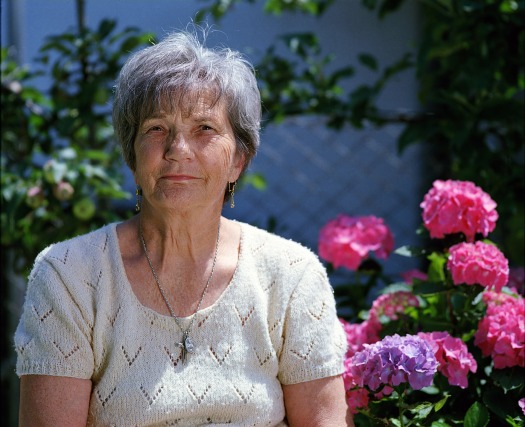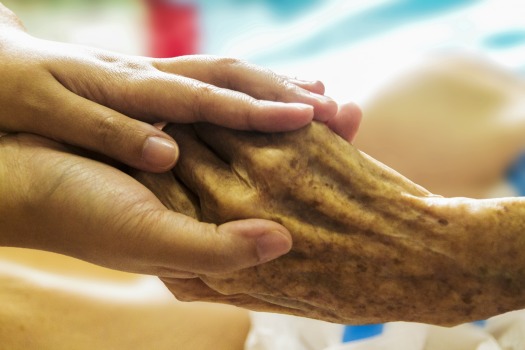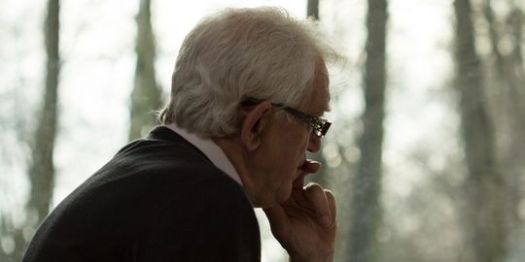Forgotten Family Caregivers
by Gale Lyman, RN, BSN, HNB-BC.
An estimated 44 million Americans are family caregivers (NAC & AARP, 2015), dedicated to caring for their loved ones. When caregiving is done, many would describe it as a sacred time, something they would willingly do again. Even so, a 2015 survey revealed that 21 percent of caregivers think providing care had made their own health worse (NAC & AARP, 2015). In the same survey, 38 percent of family caregivers said their caregiving situation was highly stressful, and 26 percent reported moderate stress. Furthermore, Wingham, Frost and Britten (2017) found that family caregivers often ignore their own health needs. The purpose of this article is to consider what happens after family caregiving is done. My intention is to spark discussions about family caregiver recovery and inspire further development of the concept. My hope is that a greater awareness of this process of caregiver recovery will guide healthcare professionals to better serve family caregivers, beginning with patient education about the life transition that occurs when caregiving is done.
Who are Family Caregivers?
Informal caregiver and family caregiver are terms used to refer to individuals, such as family members, partners, friends, and neighbors, who take care of loved ones with functional, emotional, and/or cognitive limitations due to illness or injury (FCA, 2014; NCP, 2018, p.62). These care providers may be members of the care recipient’s family of origin or family of choice (EmblemHealth & NAC, 2010). Many live with or nearby the care recipient, while some offer care long-distance.
Care recipient is a term used to describe an adult who receives regular assistance from a family caregiver (FCA, 2014). Nursing theorist Jean Watson, PhD, RN, AHN-BC, FAAN, (LL-AAN) (n.d) would likely refer to a care recipient as “the one being cared for” and the family caregiver as “the one caring.”
Family Caregiver Recovery: A Transitional Life Phase
The development of this concept occurred during a review of the literature on family caregiving and was informed by listening to hundreds of former family caregivers as well as reading many caregiver blogs, discussion forums, and support websites. It is also based on my own lived experience as caregiver for my husband, mother, and father.
While
conducting the literature survey, I realized there is a lack of healthcare
information about former family caregivers. Yet in my research, I found many
stories written by caregivers about their challenges after caregiving is done.
There is a gap between the knowledge of healthcare professionals and former
family caregivers’ need for care. They are forgotten by health care. The
exception for some caregivers is bereavement services offered by their loved
one’s hospice or palliative care services..

Photo by Ithalu Dominguez on Pexels.com
“There is a gap between the knowledge of healthcare professionals and former family caregivers’ need for care. “
In response to this gap, I coined the term family caregiver recovery. It is “a transitional life phase after a family or informal caregiver’s service is no longer needed, due to the care recipient’s death, remission, or recovery” (Lyman, 2019). Although caregivers use various terms to describe the transitional life phase of recovering after caregiving, no definitions were found during literature searches in 2017 and 2018. Family caregiver recovery is also referred to as “post-caregiving” (FCA, n.d.), “life after caregiving” (Hibbs, 2017; Crossroads Hospice Charitable Foundation, 2016), “the aftereffects of caregiving” (LeBlanc, 2015), and “Godspeed Caregiver” (Brown, 2014).
It is likely that former family caregivers experience many of the same risks and challenges identified by research pertaining to those who are still actively caring for a loved one. It stands to reason that these burdens don’t miraculously disappear when caregiving is done.
The challenges of caregiving that seem to extend into the transitional life phase of caregiver recovery can be organized into four categories:
- Family Caregiving Risks (physical, emotional, spiritual, and socioeconomic)
- Compassion Fatigue
- Major Life Changes
- Relationships
The unique experiences of individual caregivers may include characteristics of one or more of these challenges (Lyman, 2017).
What follows is an overview of these challenges. For evidence-based detail, readers may consult the defining characteristics of the NANDA-I nursing diagnosis Caregiver Role Strain (Herdman & Kamitsuru, 2018, p. 278-282), or “Key Points Pertaining to the Transitional Life Phase of Family Caregiver Recovery” (Lyman, 2019) or chapters 3 and 4 in Families Caring for an Aging America (National Academies of Sciences, Engineering and Medicine 2016).
Challenge #1: Family Caregiving Risks
A Department of Health and Human Services survey found that family caregivers reported physical (22.9 percent), emotional (44.4 percent), and financial (22.5 percent) difficulties with caregiving (Spillman, Wolff, Freedman, & Kasper, 2014). Despite the prevalence of physical and emotional difficulties, one study of active caregivers revealed that only 16 percent reported having conversations about self-care initiated by a doctor or nurse. Yet 27 percent of family caregivers surveyed thought that would be helpful (NAC & AARP, 2015). As one of the four categories of caregiver recovery challenges, “Family Caregiving Risks are the physical, emotional, spiritual and socioeconomic risk factors often experienced while caring for a loved one that continue to affect the former caregiver’s well-being and quality of life” (Lyman, 2019). In healthcare journals, caregiver burden is a common term for the potential and actual risks to a family caregiver’s body, mind, spirit, and socioeconomic conditions. NANDA-I describes this in a nursing diagnosis, “Caregiver Role Strain” (Herdman & Kamitsuru, 2018, p. 278-282). The risk factors of family caregiving are like the occupational hazards of a job.
Challenge #2: Compassion Fatigue
Compassion fatigue occurs in family caregiving relationships founded on empathy where deep stress results in physical, psychological, spiritual, and social exhaustion (Lynch & Lobo, 2012). Compassion fatigue manifests in symptoms such as sleep disturbances, depression, and substance abuse (Lombardo & Eyre, 2011). This concept is most often applied to nurses and other healthcare professionals, but the work of Lynch and Lobo (2012), Day and Anderson (2011), and Perry, Dalton and Edwards (2010) recognizes the occurrence of compassion fatigue in family caregivers as well.
Challenge #3: Major Life Changes
For family caregivers, significant life changes can occur both during and after their experience. Common changes include employment, life purpose, and lifestyle changes due to health or financial limitations accrued during their time as a family caregiver (Lyman, 2019). Sadly, “…half of the caregivers perceived life changes related to the caregiving as negative” (Negarandeh, Delkhosh, Janani, Samiei, & Ghasemi, 2015). Wingham et al. (2017) discussed the experience of new family caregivers as adapting to a new life and a new sense of who they are, and described their fear of the future being that the next transition will be life without their loved one. Afaf I. Meleis, PhD, DrPS(hon), FAAN, LL applies transitions theory to the work nurses do with people experiencing life transitions, including the transitions of family caregivers (University of Pennsylvania School of Nursing, 2018).
Challenge #4: Relationships
During and after an experience of family caregiving, problems and difficulties may occur in relationships with the care recipient, with family members, and with friends (Oldenkamp et al., 2016; Wingham et al., 2017). Relationships with friends and families may be impaired as a result of neglect, as the family caregiver was too busy or emotionally unable to maintain relationships (Day & Anderson, 2011). Conflicts among other family members regarding the care recipient’s changing family role, abilities, and need for care are common during caregiving, and continue to affect family relationships when caregiving is done (NCP, 2018; Wingham et al., 2017). NANDA-I includes many nursing diagnoses related to relationships, especially with family members (Herdman & Kamitsuru, 2018).
Bereavement
Bereavement and recovering after caregiving sometimes proceed concurrently. However, I intentionally excluded bereavement from the concept development of family caregiver recovery for several reasons.
A grieving family caregiver may not be experiencing the life transition of recovery. Almost 30 percent of caregivers surveyed report that their family caregiving experience lasted 6 months or less. Their experience as a former caregiver is likely to be quite different than the experience of the twenty four percent who provided family caregiving for five years or more (NAC & AARP, 2015). Furthermore, although 64 percent of family caregivers found their experience to be stressful, and others report that family caregiving impacted their finances, affected their ability to work, or negatively impacted their health, some do not report these challenges (NAC & AARP, 2015). At this time, we just don’t know what percentage of family caregivers are experiencing the life transition of family caregiver recovery.
Conversely, some family caregivers who are experiencing recovery may not be grieving. Anticipatory grief may have begun some time before the actual death of their loved one. The caregiver may have been adjusting to the loss of their loved one as the care recipient’s emotional, cognitive, communication, and relationship abilities declined (Boerner and Schulz, 2009; NCP, 2018).
A happy reason for separating the processes of bereavement and recovery is that sometimes care recipients recover from their illness. My husband recovered from heart failure, as do some care recipients with cancer, heart disease, catastrophic injuries, and other conditions. However, caregivers may still experience a period of recovery. One of the unique challenges of moving forward after caring for a survivor includes adjusting to the possibility that their disease may return and accepting that you do not control nor can you predict the future health of your loved one (Hibbs, 2017; Crossroads Hospice Charitable Foundation, 2016).
Fortunately, sympathy, support, and bereavement services are sometimes available through a care recipient’s hospice, palliative care program, or long term care facility. Unless a caregiver has become totally isolated, they may also receive what they need from religious or spiritual groups, their community, and hopefully from their friends. Bereavement is much better understood by our culture than recovering after family caregiving.
Conclusion
Family caregiving does have its benefits, including a closer relationship to the one being cared for and satisfaction that they are well cared for (HHS, 2014). Despite these benefits, for some, family caregiving takes a toll on their health and well-being.
Recovering from family caregiving is a process, generally handled alone by isolated family caregivers often depleted by their service to their loved ones. By assessing for family caregiving risks, compassion fatigue, major life changes, and impaired relationships in former family caregivers, healthcare professionals may gain an enhanced understanding of what challenges exist even when the family caregiving experience is over. Some caregivers navigate the transition successfully, while others get stuck along the way.
Simply raising the awareness of both professionals and family caregivers to the life transition of family caregiver recovery will help. Future research into the experience of after-caregiving and the health and well-being of former caregivers is greatly needed. Perhaps most importantly, we need research identifying nursing interventions, community services, and healthcare policy changes that help struggling former caregivers successfully navigate this life transition.

Sidebar: Holistic Tips for Recovering Caregivers
- Be gentle with yourself as you increase your self-care activities. If movement is what you need, consider stretching, walking, or chair yoga.
- Create a healing environment for yourself. Put away the medical equipment and supplies, and fill your space with who and what you love – perhaps plants, essential oils, or some new photos.
- Define and tend to your priorities; your finances, your health, housing, settling an estate, or whatever is most urgent.
- If you are isolated, gradually resume social and community activities. Start with people who are easy to love, or at least easy to be with.
- Resume arts or crafts that you enjoy, or consider taking a class to learn a new craft. For some former caregivers, this might be a non-threatening way to resume being with people. Senior centers and adult education programs may offer low cost classes.
- Put aside unrealistic expectations and set your intention to be patient. Carefully consider your self-expectations and the expectations of others before committing to new activities, responsibilities, and especially to deadlines.
- Remember what makes you smile, and what you enjoy doing. How did you spend your leisure time before caregiving?
- If you are faced with recovery challenges, get help. Or should I say, accept help? That’s often the most difficult thing for a caregiver to do.
Thank you to all who are family caregivers. The world is a better place because of you.
Gale Lyman, RN, BSN, HNB-BC is the founder of the TLC Resource Center of contemplative practices for adults, senior citizens, and caregivers at www.lymancenter.com. Contact Gale at info@lymancenter.com to further discuss this topic. Additional documents related to the concept of Family Caregiver Recovery are available at https://lymancenter.com/family-caregivers and from Gale’s blog, www.CalmAndCentered.info.
This article was originally published in Beginnings, February 2019, Vol.39:1. This article is available through the American Holistic Nurses Association as a continuing nursing education activity.
REFERENCES
Boerner, K., & Schulz, R. (2009). Caregiving, bereavement and complicated grief. Bereavement Care. 28(3),10-13.
Brown, D. (2014). After caregiving ends, A guide to beginning again. Park Ridge, IL: Tad Publishing and Consulting Co.
Crossroads Hospice Charitable Foundation. (2016, September 5). Rebuilding your life after caregiving [Blog post]. Retrieved from http://crhcf.org
Day, J.R., & Anderson, R.A. (2011). Compassion fatigue: An application of the concept to informal caregivers of family members with dementia. Nursing Research and Practice, 408024. https://doi.org/10.1155/2011/408024
EmblemHealth, & National Alliance for Caregiving (NAC). (2010). Care for the family caregiver: A place to start. The White House Conference on Aging March 2010 Edition. Retrieved from https://www.caregiving.org/pdf/resources/Emblem_CfC10_Final2.pdf
Family Caregiver Alliance (FCA), National Center for Family Caregiving. (2014). Definitions. Retrieved from https://www.caregiver.org/definitions-0
Family Caregiver Alliance (FCA), National Center for Family Caregiving. (n.d.). Post caregiving. Retrieved from https://www.caregiver.org/post-caregiving
Herdman, T. H., & Kamitsuru, S. (Eds.). (2018). NANDA International, Inc.: Nursing diagnoses: Definitions and classification: 2018-2020 (11th ed.). New York, NY: Thieme Publishers.
Hibbs, S. (2017, June 27). Now what? 10 ways to adjust to life after caregiving [Blog post]. Retrieved from http://www.cancer.net
LeBlanc, G. J. (2015). The aftereffects of caregiving. Denver, CO: Outskirts Press.
Lombardo, B., & Eyre, C. (2011). Compassion Fatigue: A Nurse’s Primer. Online Journal of Issues in Nursing, 16(1), 3.
Lyman, G. (2017). Caregiver recovery: When caregiving is finished. Presentation at Saint Anselm College, Nursing Continuing Education Program. Manchester, NH.
Lyman, G. (2019, January 10). Key points pertaining to the transitional life phase of family caregiver recovery [Blog post]. Retrieved from https://calmandcentered.info
Lynch, S.H., & Lobo, M.L. (2012). Compassion fatigue in family caregivers: A Wilsonian concept analysis. Journal of Advanced Nursing, 68, 2125-2134. https://doi.org/10.1111/j.1365-2648.2012.05985.x
National Academies of Sciences, Engineering, and Medicine (2016). Families Caring for an Aging America. Washington, DC: The National Academies Press. https://doi.org/10.17226/23606.
National Alliance for Caregiving (NAC) and the AARP Public Policy Institute. (2015). Caregiving in the U.S. 2015 – Focused Look at Caregivers of Adults Age 50+ [Research Report]. Retrieved from https://www.aarp.org/content/dam/aarp/ppi/2015/caregivers-of-older-adults-focused-look.pdf
National Consensus Project (NCP) for Quality Palliative Care. (2018). Appendix 1 of Clinical practice guidelines for quality palliative care (4th ed.). Richmond, VA: National Coalition for Hospice and Palliative Care. Retrieved from https://www.nationalcoalitionhpc.org/ncp
Negarandeh, R., Delkhosh, M., Janani, L., Samiei, N., & Ghasemi, E. (2015). The relationship between perceived life changes and mental health in family caregivers of patients with heart failure. International Journal of Community Based Nurse Midwifery, 3, 283-291.
Oldenkamp, M., Hagedoorn, M., Slaets, J., Stolk, R., Wittek, R., & Smidt, N. (2016). Subjective burden among spousal and adult-child informal caregivers of older adults: Results from a longitudinal cohort study. BMC Geriatrics, 16(208). https://doi.org/10.1186/s12877-016-0387-y
Perry, B., Dalton, J. E., & Edwards, M. (2010). Family caregivers’ compassion fatigue in long-term facilities. Nursing Older People, 22(4), 26-31. https://doi.org/10.7748/nop2010.05.22.4.26.c7734
Spillman, B., Wolff, J., Freedman, V., & Kasper, J. (2014). Informal caregiving for older Americans: An analysis of the 2011 National Study of Caregiving. Washington, D.C.: Office of the Assistant Secretary for Planning and Evaluation, U.S. Department of Health and Human Services. Retrieved from https://aspe.hhs.gov/report/informal-caregiving-older-americans-analysis-2011-national-study-caregiving
University of Pennsylvania School of Nursing. (2018). Profile, Afaf I. Meleis, PhD, DrPS(hon), FAAN, LL. Retrieved from https://www.nursing.upenn.edu/live/profiles/69-afaf-i-meleis
Watson, J. (n.d.). Caring Science Theory. Watson Caring Science Institute. Retrieved from https://www.watsoncaringscience.org/jean-bio/caring-science-theory
Wingham, J., Frost, J., & Britten, N. (2017). Behind the smile: Qualitative study of caregivers’ anguish and management responses while caring for someone living with heart failure. BMJ Open, 7(7). https://doi.org/10.1136/bmjopen-2016-014126




One Comment
Comments are closed.